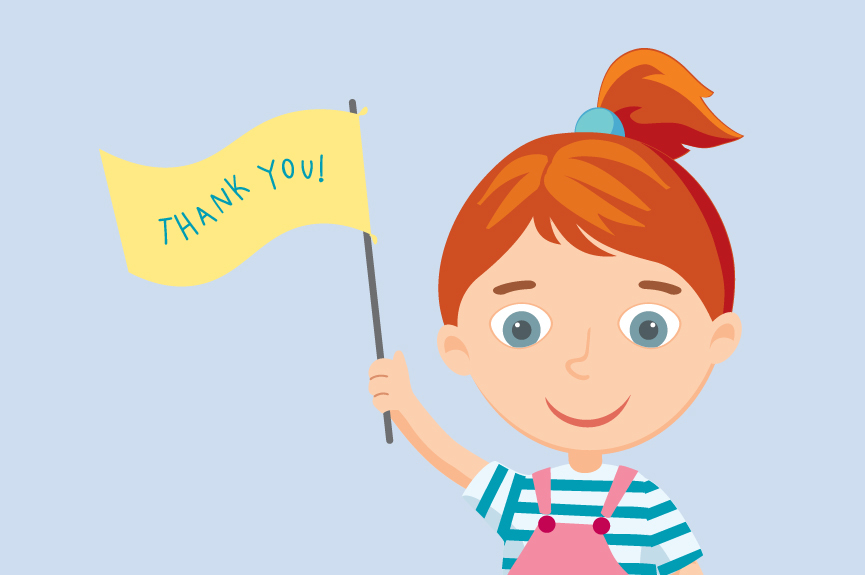
In the spirit of Thanksgiving, this is a great time to teach your kids how to practice having a thankful attitude. Gratitude helps people look at different situations from a positive perspective, and it is a mindset that will benefit your child in the long run when they face difficult situations.
A 2019 study from the Journal of Happiness Studies found an association between happiness and gratitude in children at age 5. Gratitude has also been found to increase greater satisfaction in life and help children to have a better attitude towards school. It has also been found to help build resilience over time in children as they focus on celebrating the present moments and things they have.
So, how do you teach this abstract concept to your kids? There are several activities and resources you can use with them to help cultivate an attitude of gratitude that will last longer than the holiday season.
Gratitude is more than just saying thank you; it’s about digging deeper and having conversations about how thankfulness looks. According to the Raising Grateful Children Project at UNC Chapel Hill, there are four steps in gratitude:
- Notice moments to be grateful. Help your child first notice those moments when they can appreciate a person, place, or thing. Did someone do something nice for you? Did you have a fun time in a particular place?
- Think about why you’re grateful. Once you help your child notice those moments, ask them why they might be thankful for them. What are the reasons why you are thankful? Does it mean something special to you? Is it fun or exciting? Did someone do something nice for you, and why do you think they did?
- Acknowledge the feelings. When they think about why they are thankful for a moment or person, ask your child to verbalize how it makes them feel. Do they feel proud, happy, excited, or peaceful when they think of why they are grateful?
- Act on it. Help your child think of ways to express their gratitude for this person, place, or thing. They can write notes, draw pictures, or pay it forward by doing something nice for someone else.
You can find numerous activities to do with your child on the Internet to help them think about what they are grateful for in more concrete ways, but here are some ideas to get you started.
Decorate a gratitude jar. You can work with your kids to decorate a jar of any size and then keep it on their desk or somewhere in their room. Whenever they think of something to be thankful for throughout the day, they can write it down on a slip of paper and add it to the jar.
Keep a gratitude journal. This can work for kids of all ages. Some may express themselves better through drawing or painting, while others may want to spend more time writing their thoughts down. Regardless, keeping it all in one place allows you to look back and remind yourself of all the things you are grateful for.
Share at the dinner table. You can express thankfulness as a daily ritual by talking about what you and your family are grateful for each day during dinner or before bedtime.
Create a gratitude collage. For families that enjoy doing arts and crafts together, create a collage of things that you’re thankful for with your child. You can cut out pictures from magazines, use family photos, or print out images to include. You can hang it on the refrigerator or any place where you and your child can look back on it and remember to be thankful.
Find the silver lining. Shifting a child’s perspective from negative to positive will take time and effort, but in bad situations, ask them questions to help them see another side of it.
Take gratitude walks. When you’re getting some fresh air with your child, take the time to discuss what you and your child can be thankful for, such as the sunshine or the chilly weather. Look for the simple pleasures in the day and help your child to notice those moments that are often taken for granted.
Instilling a grateful attitude in your child will not happen overnight, but it is a great time to start with Thanksgiving right around the corner. Overall, children learn best from the way you act. Modeling an attitude of gratitude for your child will be the most effective way to teach them to be thankful for the little and big things no matter what kind of situation they face.

Emily currently lives in Orange County, California after spending four years in Illinois and half a year teaching in Florence, Italy. She holds a B.A. in English Literature from Knox College and an M.A. in Counseling from the University of San Diego and has taught English to native speakers and ESL students for over three years. When she’s not working as a School Counselor or writing, she enjoys traveling the world, playing instruments, and blogging about Millennial experiences at Long Live the Twenties.
